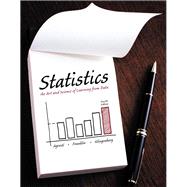For courses in introductory statistics.
The Art and Science of Learning from Data
Statistics: The Art and Science of Learning from Data, Fourth Edition, takes a conceptual approach, helping students understand what statistics is about and learning the right questions to ask when analyzing data, rather than just memorizing procedures. This book takes the ideas that have turned statistics into a central science in modern life and makes them accessible, without compromising the necessary rigor. Students will enjoy reading this book, and will stay engaged with its wide variety of real-world data in the examples and exercises.
The authors believe that it’s important for students to learn and analyze both quantitative and categorical data. As a result, the text pays greater attention to the analysis of proportions than many other introductory statistics texts. Concepts are introduced first with categorical data, and then with quantitative data.
Also available with MyStatLab
MyStatLab™ is an online homework, tutorial, and assessment program designed to work with this text to engage students and improve results. Within its structured environment, students practice what they learn, test their understanding, and pursue a personalized study plan that helps them absorb course material and understand difficult concepts. For this edition, new web apps with complementary exercises, a tightly integrated video program, and strong exercise coverage enhance student learning.
Note: You are purchasing a standalone product; MyLab™ & Mastering™ does not come packaged with this content. Students, if interested in purchasing this title with MyLab & Mastering, ask your instructor for the correct package ISBN and Course ID. Instructors, contact your Pearson representative for more information.
If you would like to purchase boththe physical text and MyLab & Mastering, search for:
0134101677 / 9780134101675 * Statistics Plus New MyStatLab with Pearson eText -- Access Card Package
Package consists of:
0321847997 / 9780321847997 * My StatLab Glue-in Access Card
032184839X / 9780321848390 * MyStatLab Inside Sticker for Glue-In Packages
0321997832 / 9780321997838 * Statistics: The Art and Science of Learning from Data











